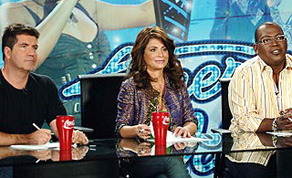Until May of this year, paid product placement was prohibited in Irish programming, with free product placement also limited. The Broadcasting Authority of Ireland (BAI) has since changed its rules, opening up a new market in Ireland. IFTN spoke to key figures in the industry to find out how this will effect Irish Television.
Earlier this month a brand new SPAR store opened in Carrigstown, as RT╔’s long running soap ‘Fair City’ became host to the second product placement deal on Irish television, after TV3 and Kenco signed a deal for brands to appear on ‘The Morning Show’ earlier this year.
Product placement is when a company pays a TV channel or a programme-maker to include its products or brands in a programme. Viewers of American television have been exposed to it for years; ‘America Idol’ fans will be quite used to seeing Simon Cowell sipping Coca-Cola as he passes judgement on the show’s aspiring pop-stars.
Until earlier this year it was prohibited in domestically produced programming, but the Broadcasting Authority was forced to change the rules governing product placement after recognition at European Union level in 2007 that the television advertising goalposts had shifted dramatically.
For Larry Bass, CEO of Screentime ShinAwiL (The Apprentice), the move to allow product placement in Ireland represents a natural step. “Paid for product placement has come in, it now means that you have the opportunity to have brands pay to have their brand in the show. For example, Ford very famously spent a lot of money placing their vehicles in movies like James Bond. Now you could have a situation where producers of drama or entertainment TV shows can actually approach brands and encourage them to feature their brand in the show.”

James Bond Daniel Craig |
While the change in regulations is a welcome one, the Irish industry will have to play catch up with its counterparts across the Atlantic. “What we are dealing with are things that have been around in some shape or form, its now just becoming a commercial reality,” said Bass, “there is a whole industry in the US, companies who specialise in getting products into TV shows and movies. It is going to take time for European companies to grapple and grasp with this. That comes through a process where, the industry, both the television industry and the advertising industry, and the actual brands themselves, have to educate themselves on how this will work.”
One of the key questions in this new market is how it will directly effect producers, and how involved they will be in the process; “Producers will never be involved in a discussion about advertising, the advertising breaks in shows will always be between the broadcaster, the agency and the brand,” said Bass, “Similarly in product placement, I think people need to be aware, this isn’t going to be the pot of gold at the end of a rainbow. I think what this will do is help negate some of the reductions in advertising spend. But not every show will be suitable, and I don’t believe producers will be the first people to be initiating those conversations.”
That does not mean, however, that producers cannot be involved in process; “There are levels of conversations, there are cross purposes involved. I think producers will always remain the guardians of the editorial independence of a show,” said the IFTA winning producer, “In a difficult market, it’s important to be aware that there are other means of generating revenues around shows, and when and if opportunities arise, I think it’s important to share that with potential broadcasters and/or brands and try and be the organiser of a marriage of convenience.
“But I think you can very quickly fall into the roll of trying to spend your time finding brands who want to jump into TV shows, and you can waste a lot of time for a little reward. So I think it’s acutely important that people see this out, be aware of it, know that there are opportunities out there, and these are important opportunities in a difficult commercial market.”
One of the biggest changes in television advertising has been the proliferation of digital video recorders (DVR) such as Sky+, which allow viewers to record programmes and then fast-forward through the ads, a technological advance which had significantly threatened many broadcasters’ income from advertising revenue.
For Daragh Byrne, Head of Sales at TV3, and a key figure in Ireland’s first product placement deal, it is far too early for the bell to toll on the 30-second ad spot; “We have been talking about the death of the 30 second spot now for ten years maybe, and it hasn’t happened. In fact people are watching more television now than they did ten years ago, so it’s not going to happen. I think people will definitely look to product placement on other forms of communication to try and achieve that cut through. I think it will become more important, more prevalent, and it is a very premium product.”
 American Idol
American Idol |
So are Irish audiences likely to be flooded with product placement in their favourite programmes? Not if product placement is to be seen as a premium product in the future according to Byrne; “The reason we have to be careful is because product placement is such a premium product, and you cannot just flood the market with a shed load of opportunities because it then just doesn’t carry that premium perception.”
According to Gerry McGuinness, Sponsorship Manager at RT╔ Television and a key figure in the ‘Fair City’ SPAR deal, RT╔ are trying to manage the situation and ensure it doesn’t have an adverse effect on audiences; “We are trying to do it in a managed situation where it’s not grossly jarring, it should be a natural fit. The other thing is that of course while we will target the things that are appropriate for when we see a new programme coming along that someone could have product placement in it maybe adding to the show rather than in the opposite effect.
“We will not do it if it takes away, in any way, from the credibility of the show or the performers or the presenters. I think while we will be looking at the appropriate ones it’s also good to bear in mind what revenue can be attributed to that. We’ll be looking at long term deals that will feature prominently, that will add to the money that we can put towards the production of the programme, and everybody is happy with the arrangement.”
With the market in its infancy, Declan McLoughlin, Policy Officer at the BAI explained how important it is for broadcasters to be transparent about placements and also pay consideration to its audience; “It’s early days to talk about implementation of rules but I suppose best practice would be that any product placement would be incidental to the programming, that it wouldn’t drive editorial content, that it wouldn’t influence editorial content and that it wouldn’t amount to advertising, and obviously that it would be very transparent to audiences.”
Broadcasters must adhere the BAI’s code when using placements in programmes; while it’s too early to judge any standard or compliance, the BAI is clear in its guidelines according to McLoughlin; “Essentially there are a couple of requirements; first, before any programme with paid product placement or free product placement there must be an on-screen message that tells audiences the following programme contains paid or free product placement; there then has to be a ‘PP’ logo at the beginning of the programme and at the end of ad breaks returning to programmes, and also the providers of any product placement paid or otherwise must be identified in the end credits.”
So does McLoughlin expect any audience backlash? “I think if it’s done appropriately audiences are unlikely to have too much of a problem, but it depends on whether rules are complied with. Audiences are very familiar with product placement already from watching American programming, films and Australian content; it’s not a new concept. The question will be whether the editorial content has been made subservient to the commercial arrangement, and that just leads to bad television.”
According to research by YouGov, product placement in TV shows and films is widely recognised and accepted by UK consumers. In a survey carried out by the company in late July, 59% of those polled said they see products featured in films and international TV programmes all the time and it makes no difference to their viewing experience.
Nearly half (46%) said that having real products in TV programmes will make the programme look much more realistic, while a third of people disagreed that product placement negatively impacts the integrity of a TV programme, with a further third taking a neutral view.
One of the difficulties from an industry perspective is to evaluate and quantify a placements value. Danny Townsend, President of Repucom International Europe, has worked with TV3, ITV and Channel 4 to track brand and product exposure within programmes; “The trend is away from people consuming 30 second commercials,” says Townsend. “Therefore the in-programme content becomes the gold. How you activate in-programme is obviously limited by what the regulations allow, but used together with 30 second commercials I think the whole notion of ad funded programming, product placement etc is a really interesting way to engage consumers, particularly given you are inside a programme and somewhat unavoidable.”
With Repucom working with brands around the world, Townsend was able to share some of the company’s experience dealing with the emerging market; “Some of the experience we have is with brands being a little bit scared to push the boundaries, purely because they fear they might disenfranchise a viewer. We have a lot of examples where brands have tried to be subtle in there integration, and been so subtle that no one actually knew they were there, which effectively meant they wasted a lot of money. I think in this day and age consumers are used to being exposed to brands. I think ITV led the way in the UK, the fact that having brands inside drama series and reality shows makes them feel more real, which in fact enhances the quality of the programming rather than detracts from it.”
For further information about the Ireland product placement codes and regulations visit www.bai.ie
